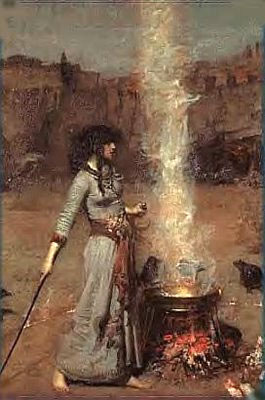What’s Cooking? – 1
More Thoughts on Prophetic Cauldrons
“Double, double toil and trouble
Fire burn, and cauldron bubble.”
Macbeth, Act 4, Scene 1
.
Two days ago, we saw the Lord take Jeremiah through the Creation/Tabernacle pattern as He anointed him. Here’s some more thoughts on the Babylonian “seething pot” using the Tabernacle pattern as a guide.
Usually, the Lampstand is at the centre of the passage (Pentecost). But the almond tree/Lampstand here is at Firstfruits. The Land of Day 3 is the Bronze Altar, but the grain and fruit (the Table) is replaced here by the almond).
Jeremiah, as a sign to Israel, is made the incarnation of Yahweh. The seven-eyed “watching tree” is actually Jeremiah, and the Lord continually asks him to “see.” As the prophetic Lampstand watched over Israel (the Table), so Jeremiah would watch over her destruction.[1] The Table seems to be covered by Nebuchadnezzar!
Cauldrons are big bowls suspended over a fire. Here, at Day 4, instead of the Lampstand being the fire on the altar (the ruling lights on the land), there is a foreign laver suspended between heaven and earth. This ties in with the floodgates of heaven being opened. The laver tipped water down and the fountains of the abyss burst open to cover the Land/Altar. Israel, as the mediatorial uplifted land, was about to go under. The fact that the Babylonian cauldron tips down upon Israel perhaps refers to the exaltation of Nebuchadnezzar’s kingdom by God to the place of the sun, moon and stars, the firmament. Isaiah 13 uses this imagery concerning Babylon’s demise.
Being suspended between heaven and earth, the cauldron is a mediator. On top of all the Temple vessels, the Lampstand itself had seven separate bowls that sat on the stems. The structure of the seven bowls passage in Revelation also puts these at the centre of that passage. The final seven angels are the seven spirits of God putting holy fire on the sons of Aaron.
“And the word of the LORD came unto me the second time, saying, What seest thou? And I said, I see a seething pot; and the face thereof is from the face of the north.”
We seem to have Jeremiah in the south as the Lampstand looking north, and the cauldron in the north tipped southwards. The references to face align Nebuchadnezzar with the “Man” face of the cherubim. With the failure of Israel’s kings to be men instead of beasts, King Neb became the servant of God against them. As a substitute Table, he was an ironic altar from the abyss, a payback for Israel’s slaughter of innocent children to foreign gods.[2] Babylon was actually in the east, although the armies entered Israel from the north apparently. Nebuchadnezzar, as God’s servant, was also an incarnation of Yahweh.
“Behold, I will send and take all the families of the north, saith the LORD, and Nebuchadrezzar the king of Babylon, my servant, and will bring them against this land, and against the inhabitants thereof, and against all these nations round about, and will utterly destroy them, and make them an astonishment, and an hissing, and perpetual desolations.” Jeremiah 25:9
“And now have I given all these lands into the hand of Nebuchadnezzar the king of Babylon, my servant.” Jeremiah 27:6
Because of Israel’s failure to be a laver of living water overflowing into the Gentile nations, Yahweh brought the frothing abyss to the boil and unleashed it as a lake of fire upon the whole world.
Pentecost is the step where the Law is opened to Israel. Here the curses of the Law are poured out to bring death and resurrection. Israel was being “served.”
Perhaps there is also the form of a pregnancy, which is common in this pattern. Israel’s harlotry was coming full term, and the offspring of this was not a man but Leviathan. Dinner was being served, too. Instead of bread and wine there was death in the pot.
_________________________________________
[1] Ezekiel, too, was made a watchman.
[2] See articles on this horrific biblical theme here.


























